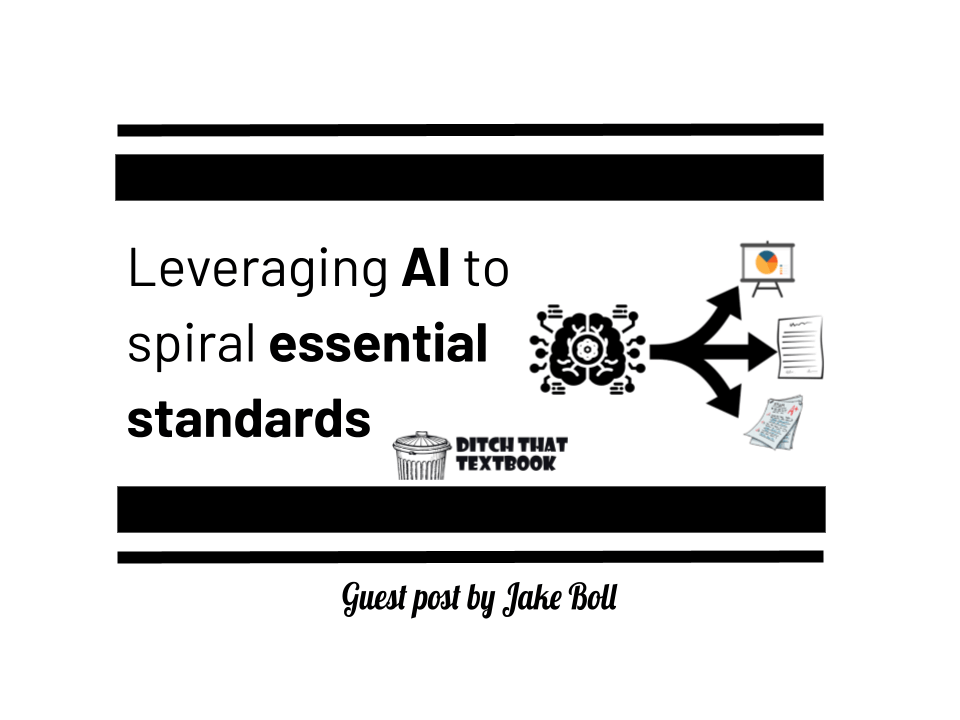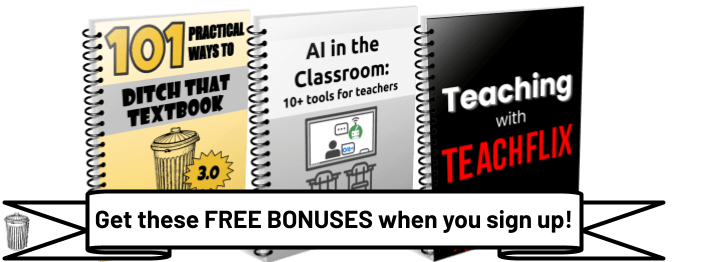
Jake was a HS social studies teacher before joining the team at CESA 5 in Wisconsin as a curriculum and ed tech specialist. Some favorite ed tech topics include digital citizenship and media literacy, inquiry based learning, standards based grading, AI, and UDL. He's also a HS cross country coach, husband, and father of three great young kids! You can find him on Twitter @JakeJrboll
Teaching twenty standards doesn’t mean that students are learning twenty standards. For that reason, many educators have worked hard to determine the essential standards for their content areas and then work to spiral assessments for these standards.
Spiraling involves revisiting key concepts and skills throughout the academic year, ensuring that students not only understand them, but also retain and apply them effectively.
For example, when I taught high school history, my inquiry based classroom followed these following five essential standards that could be spiraled unit after unit. This worked well because even as the topic or course content changed, the skills of the essential standards remained the same.

Once my colleagues and I determined the essential standards for our content area, we then determined what proficiency looks like for each standard in our classroom and grade level. This allowed us to craft proficiency scales and convert our gradebook to a standards based grading format.
But regardless of what gradebook you use, know that proficiency scales are useful tools that both teachers and students can use to track learning progress. They also allow multiple ways for students to demonstrate proficiency so long as they meet the criteria required by the scale.
While this certainly sounds reasonable and relatively easy, we run into hang ups when we teach topics that don’t easily align with our essential standards. So what do we do? We typically choose one of three doors:
Door #1: Cut that topic since it does not meet our essential standards.
Door #2: Add more essential standards so we can teach this topic and align it to the new standard.
Door #3: Adjust the topic so that it better aligns with our already established essential standards.

Many educators may take door #1 and decide to cut a topic because it doesn’t fit well. Or, they may teach the topic, but decide not to assess the topic since they only assess on the essential standards. This makes sense. However, if we don't assess the topic, how do we know whether or not students actually learned it?

Others may choose door #2 and add more essential standards. This allows us to align the topic with new essential standards that students will be assessed on. This also makes sense. However, if we declare too many essential standards, we’re back to square one when we taught too much and student’s didn’t have multiple attempts to demonstrate proficiency in the standard.

This leaves us with door #3. This has been a tricky door for us in the past because it can be difficult to take a topic that doesn’t naturally fit into an essential standard and try to force it. It’s the old adage of putting a square peg in a round hole. We may feel that a topic is important for students to understand, but we struggle if it does not align perfectly with the essential standard. Enter artificial intelligence.
AI tools require three simple inputs to help us align different topics or content with our essential standards.

We now have tools at our disposal to better align any topic or content to our essential standards with the help of AI.
Topic + Grade Level Audience + Essential Standards and Learning Targets = AI aided lesson plans, presentations, assessments, and more.
Take my US History class again as an example. As my students progress through the units in chronological order, they are assessed on the same essential standards multiple times.

If I need a little support connecting the topic of my next unit to my essential standards, I now have an intelligent friend to help me do it. Do I need a presentation on the Age of Jefferson that focuses on the contentious issues of the day for my students to analyze? I can add my three inputs into an AI tool like Curipod and I’ve got it!
Need an assessment for the Era of Good Feelings that focuses on analyzing a primary source? I can add the document and my three inputs into an AI tool like Questionwell and have an assessment with multiple DOK level questions in seconds.
Teachers are now empowered to connect any topic or content to course essential standards thanks to the power of new AI tools. Of course, the teacher is still the expert that is going to corroborate the AI and make improvements, but it creates a great rough draft!
I encourage you to try it for yourself. Once you have determined essential standards as well as what proficiency looks like, experiment with an AI tool like magicschool.ai.
Just follow the formula of adding your TOPIC + GRADE LEVEL + ESSENTIAL STANDARD and have AI create a spiraling resource that allows you to use door #3. I’m excited to see what you and your intelligent friend come up with!


